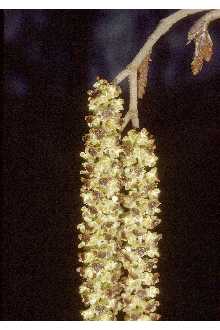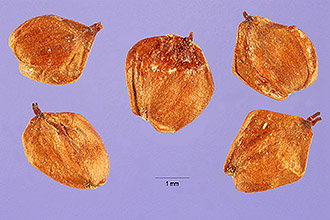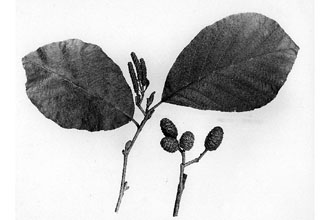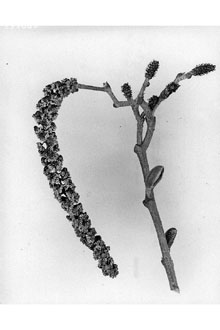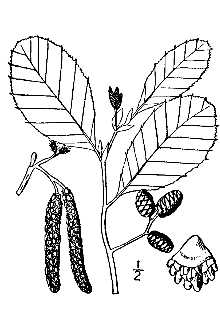Speckled Alder
Scientific Name: Alnus incana (L.) Moench ssp. rugosa (Du Roi) R.T. Clausen
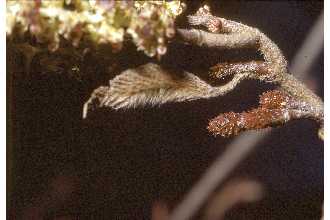
| General Information | |
|---|---|
| Usda Symbol | ALINR |
| Group | Dicot |
| Life Cycle | Perennial |
| Growth Habits | ShrubTree, |
| Native Locations | ALINR |
Plant Guide
Alternate Names
Tag alder, gray alder, hoary alder, hazel alder, swamp alder; Alnus rugosa (Du Rois) Spreng, Use soil moisture sensors to measure the soil moisture of Speckled Alder.,; Alnus americana (Regel) Czerp,
Uses
Speckled alder is used locally for fuel but the wood has no commercial value. Because root nodules of alders support nitrogen-fixing bacteria, yields of timber-producing trees can be enhanced when grown in association with alder, in the same way that leguminous crops increase production in agricultural crops. The nitrogen-enhancing effect is local and restricted to trees in the immediate vicinity of the alder. Rapid growth in open habitats, wide tolerance to soil types, and potential for soil conditioning make it useful in rehabilitation of disturbed sites, including old mines. Alders are beautiful and functional plants and deserve to be more widely grown in gardens and nurseries. They are fast growing and can easily be trained to a tree-like form by removing lower branches. Wildlife: Speckled alder thickets provide cover for moose, white-tailed deer, rabbits, and others. Moose, muskrats, beavers, and rabbits browse the twigs and foliage. Songbirds, including redpolls, goldfinches, woodcock, and grouse eat the seeds, buds, and catkins. Beavers build dams and lodges with speckled alder. USDI, GS, BRD, Northern Prairie Wildlife Research Center Ethnobotanic: Native Americans used speckled alder to treat anemia, as an emetic, a compress or wash for sore eyes, and a diaphoretic, for internal bleeding, urinary problems, sprains, bruises or backaches, itches, flux, and piles, to cure saddle gall in horses. When mixed with powdered bumblebees, it was used as an aid for difficult labor. Tea was made from alder to cure diarrhea and toothaches. Other bark mixtures were applied to rashes, eyes, and swelling. Chippewa Indians mixed alder root scraping with grounded up bumblebee and fed the mixture to women whom were having difficulty during childbirth. Erosion Control: Speckled alder’s acceptance of a wide variety of soil types makes it a good choice for disturbed site rehabilitation. This is a valuable species to plant along stream banks for erosion control.
Status
Please consult the PLANTS Web site and your State Department of Natural Resources for this plant’s current status, such as state noxious status and wetland indicator values.
Description
General: Birch Family (Betulaceae). Native shrubs and (less commonly) small trees growing to 10 m tall, thicket-forming, with open crowns. The bark is gray, reddish, or brown, thin and smooth, becoming broken into irregular plates, often with conspicuous whitish lenticels (spongy openings for gas exchange). Leaves are elliptic to ovate, 4-11 cm long, 3-8 cm wide, broadest near or below middle, doubly and irregularly toothed, with 9-12 nearly straight, parallel veins on each side, with a ladder-like network of depressed veins, dull dark green above. Male (pollen, staminate) and female (seed, pistillate) flowers are in catkins, borne separately, but on the same tree (the species monoecious). The seed catkins are cone-like, cylindric to ovoid, 1-2 cm long, erect, sessile or on a short, stout stalk, generally remaining intact after release of fruits in spring. The pollen catkins are elongate, 2-7 cm long, in hanging clusters from near the shoot tip. The common name (speckled) is in reference to the numerous lenticels covering the bark. Variation within the species: Speckled alder is similar in growth form and habitat to mountain alder (Alnus tenuifolia), which ranges from Alaska, Yukon, and Mackenzie southward to New Mexico. In mountain alder, the leaf blades are thin and papery, with rounded or blunt teeth, compared to the thick leaf blades with sharp teeth in speckled alder; mountain alder also is more treelike than speckled alder. They intergrade where their distributions overlap in Saskatchewan westward. Eurasian or European alder (Alnus incana) also is similar to these North American natives. When these three are ‘lumped’ (considered to represent only a single species, using the oldest name), the nomenclature is summarized as below. Many still consider them to represent three separate species. • Alnus incana (L.) Moench ssp. incana – European alder • Alnus incana ssp. rugosa (Du Roi) Clausen – speckled alder synonym: Alnus rugosa (Du Roi) Spreng. synonym: Alnus incana var. americana Regel synonym: Alnus rugosa var. americana (Regel) Fern. • Alnus incana ssp. tenuifolia (Nutt.) Breitung – mountain alder synonym: Alnus tenuifolia Nutt. synonym: Alnus incana var. occidentalis (Dippel) C.L. Hitchc. Brookside alder (Alnus serrulata), a species of the eastern and southeastern USA, has sometimes been included as a subspecies of A. incana but is now generally regarded as a separate species. Hybrids occur where brookside alder and speckled alder grow together.
Distribution
Speckled alder ranges over much of the eastern two-thirds of Canada and reaches into Alberta, British Columbia, Mackenzie, and Yukon. In the USA, it reaches into the Lake States and Northeast and as far south (at higher elevations) as Iowa, West Virginia, Maryland, and Virginia. For current distribution, please consult the Plant Profile page for this species on the PLANTS Web site.
Establishment
Adaptation: Speckled alder colonizes stream banks, lake shores, and damp meadows and also occurs in bogs and nutrient-rich swamp communities, at 0-800 meters. It is weedy in damp areas along roadsides and other disturbed sites. It grows abundantly in various soil types, from sandy to gravelly, loamy, clayey, and mucky, and it can tolerate periods of flooding as well as occasional droughts. It often dominates the understory in communities of black spruce, balsam fir, jack pine, tamarack, northern white-cedar, balsam poplar, and birch-aspen, but growth and reproduction occur most vigorously in full sun. Overstory removal brings rapid release of speckled alder, which may form dense, nearly pure thickets. Gaps created by fire and logging in these wetland forests are quickly invaded by speckled alder. Flowering occurs in early spring (March–May), before the leaves appear, the inflorescences formed in late summer the season before flowering. Fruit maturation is in late August–September with the seeds dispersed the following spring. Propagation by Seed: Speckled alder can be propagated by seed or by cuttings. Seeds are shaken from dried cones collected in September and October and can be stored air-dry in sealed containers for several years. They are most easily sown in a cold frame immediately after ripening, in sand or a sand-humus mixture. Spring planting of seeds collected earlier requires stratification in moist sand or vermiculite for 60-90 days at 5° C. Seedbeds should be kept moist and shaded until late in the summer. Germination rates are often low. Softwood cuttings taken in summer, treated with rooting promoter, and rooted under mist provide good starts; cuttings of mature wood taken soon after leaves fall also are reported to be effective. Two or three year-old seedlings are used for field planting. General: Flowering and fruit production begin at about 5-10 years, with abundant fruit crops produced at about 4-year intervals. An optimal seedbed for germination is exposed, constantly moist mineral soil. Mild intensity burning and scarification also encourage regeneration. Individuals of speckled alder are fast growing, but short-lived. Most new stems in alder stands are formed through sprouting from rhizomes, which may result in dense, clonal thickets. Such sprouting is independent of aboveground stem damage, but root crown sprouts may contribute strongly to regeneration following top-kill from fires. Sprouting rhizomes are usually within about 5 centimeters of the soil surface.
Management
Alders have relatively few insect or disease problems, although alder psyllid and alder blight aphid can damage the leaves. Mild spring and early summer fires that kill only the aerial stems are recommended for regeneration of speckled alder. Severe fires that remove the organic layer and expose and char root crowns can completely eliminate sprouting in speckled alder or significantly retard regeneration. Fire intervals of about 9 years are adequate to keep speckled alder stands at an early successional stage. Longer intervals may encourage the expansion of alder thickets at the expense of other forest types. Alder patches of various age classes can be maintained by staggered cutting and provide the best wildlife cover. Spring and winter cutting produces the most rapid sprout growth. Cultivars, Improved and Selected Materials (and area of origin) A few cultivars have been developed from Alnus incana (the European populations, see above): 'Aurea' has new yellow foliage and bright yellow-orange male catkins; 'Laciniata' is a cut leaf form with exceptionally deep lobing; 'Pendula' is a weeping form.
References
Barnes, B.V. & W.H. Wagner, Jr. 1981. Michigan trees. The University of Michigan Press, Ann Arbor, Michigan. Britton, N.L. 1908. North American trees. Henry Holt & Company, New York, New York. Brown, C.A. 1965. Louisiana trees and shrubs. Claitor’s Bookstore, Baton Rouge, Louisiana. Curtis, J.T. 1959. The vegetation of Wisconsin. The University of Wisconsin Press, Madison, Wisconsin. Furlow, J.J. 1979. The systematics of the American species of Alnus (Betulaceae). Rhodora 81:1–121, 151–248. Furlow, J.J. 1993. Alnus. Pp. 509-516, IN: Flora of North America, North of Mexico. Vol. 3. Oxford Univ. Press, New York. Accessed September 2000 <http://hua.huh.harvard.edu/cgi-bin/Flora/flora.pl?FLORA_ID=12395> Green, C.H. 1939. Trees of the south. The University of North Carolina Press, Chapel Hill, North Carolina. Grimm, W.C. 1967. Familiar trees of America. Harper & Row, Publishers, New York, New York. Grimm, W.C. 1970. Home guide to trees, shrubs, and wildflowers. Stackpole Books, Harrisburg, Pennsylvania. Hamann, A. 1999. Utilization and management of red alder [Alnus rubra] genetic resources in British Columbia. Ph.D. dissertation. Dept. of Forest Science, Univ. of British Columbia. <http://genetics.forestry.ubc.ca/hamann/phthesis/phthesis.html> Accessed September 2000. Healy, W.M. & J.D. Gill 1974. Shrubs and vines of northeastern wildlife. U.S. Department of Agriculture, Forest Service. Hosie, R.C. 1969. Native trees of Canada. 7th ed. Canadian Forest Service, Department of Fisheries and Forestry, Ottawa, Ontario, Canada. Hylander, N. 1957. On cut-leaved and small-leaved forms of Alnus glutinosa and A. incana. Svensk Bot. Tidskr. 51:437–453. Murai, S. 1964. Phytotaxonomical and geobotanical studies on gen. Alnus in Japan (III). Taxonomy of whole world species and distribution of each sect. Bull. Gov. Forest Exp. Sta. 171:1–107. Trappe, J.M., J.F. Franklin, R.F. Tarrant, & G.M. Hansen (eds.) 1968. Biology of alder. USDA, Forest Service, Portland, Oregon. USDA NRCS 2003. The PLANTS database. National Plant Data Center, Baton Rouge, Louisiana. <http://plants.usda.gov>. Version 030127. Van Deelen, T.R. 1991. Alnus rugosa. IN: W.C. Fischer (compiler). The fire effects information system [database]. USDA Forest Service, Intermountain Research Station, Intermountain Fire Sciences Laboratory, Missoula, Montana. <http://www.fs.fed.us/database/feis/plants/shrub/alnrug/>
Plant Traits
Growth Requirements
| Temperature, Minimum (°F) | -47 |
|---|---|
| Adapted to Coarse Textured Soils | No |
| Adapted to Fine Textured Soils | Yes |
| Adapted to Medium Textured Soils | Yes |
| Anaerobic Tolerance | High |
| CaCO3 Tolerance | Medium |
| Cold Stratification Required | Yes |
| Drought Tolerance | Low |
| Fertility Requirement | Medium |
| Fire Tolerance | Medium |
| Frost Free Days, Minimum | 80 |
| Hedge Tolerance | Low |
| Moisture Use | Medium |
| pH, Maximum | 7.7 |
| pH, Minimum | 4.8 |
| Planting Density per Acre, Maxim | 1200 |
| Planting Density per Acre, Minim | 700 |
| Precipitation, Maximum | 65 |
| Precipitation, Minimum | 21 |
| Root Depth, Minimum (inches) | 24 |
| Salinity Tolerance | Low |
| Shade Tolerance | Intermediate |
Morphology/Physiology
| Bloat | None |
|---|---|
| Toxicity | None |
| Resprout Ability | Yes |
| Shape and Orientation | Semi-Erect |
| Active Growth Period | Spring and Summer |
| C:N Ratio | High |
| Coppice Potential | Yes |
| Fall Conspicuous | No |
| Fire Resistant | No |
| Flower Color | Yellow |
| Flower Conspicuous | No |
| Foliage Color | Dark Green |
| Foliage Porosity Summer | Dense |
| Foliage Porosity Winter | Moderate |
| Foliage Texture | Coarse |
| Fruit/Seed Conspicuous | No |
| Nitrogen Fixation | Low |
| Low Growing Grass | No |
| Lifespan | Long |
| Leaf Retention | No |
| Known Allelopath | No |
| Height, Mature (feet) | 16.0 |
| Height at 20 Years, Maximum (fee | 16 |
| Growth Rate | Moderate |
| Growth Form | Multiple Stem |
| Fruit/Seed Color | Brown |
Reproduction
| Vegetative Spread Rate | Slow |
|---|---|
| Small Grain | No |
| Seedling Vigor | Low |
| Seed Spread Rate | Slow |
| Seed per Pound | 1084250 |
| Fruit/Seed Persistence | Yes |
| Propagated by Tubers | No |
| Propagated by Sprigs | No |
| Propagated by Sod | No |
| Propagated by Seed | Yes |
| Propagated by Corm | No |
| Propagated by Cuttings | No |
| Bloom Period | Early Spring |
| Commercial Availability | Routinely Available |
| Fruit/Seed Abundance | Low |
| Fruit/Seed Period Begin | Spring |
| Fruit/Seed Period End | Fall |
| Propagated by Bare Root | Yes |
| Propagated by Bulb | No |
| Propagated by Container | Yes |
Suitability/Use
| Veneer Product | No |
|---|---|
| Pulpwood Product | No |
| Protein Potential | Low |
| Post Product | No |
| Palatable Human | No |
| Palatable Graze Animal | Low |
| Palatable Browse Animal | Low |
| Nursery Stock Product | Yes |
| Naval Store Product | No |
| Lumber Product | No |
| Fuelwood Product | Low |
| Fodder Product | No |
| Christmas Tree Product | No |
| Berry/Nut/Seed Product | No |

